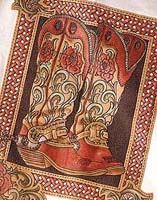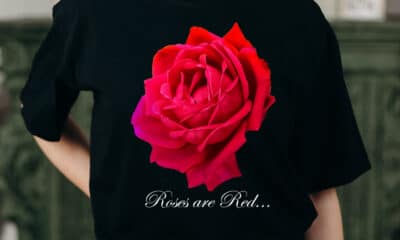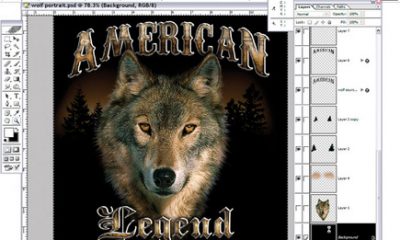Digital Printing
Published
11 years agoon

Technology changes many industries eventually. Though UV curing has been in the printing industry for more than 20 years, LED curing technology for UV printers is a modern technological twist in digital imaging. For a new technology to take hold, users have to feel a compelling need to accept it.
Technology changes many industries eventually. Though UV curing has been in the printing industry for more than 20 years, LED curing technology for UV printers is a modern technological twist in digital imaging. For a new technology to take hold, users have to feel a compelling need to accept it.
How is the technology taking hold? We talked to some printers about UV inkjet printing and UV LED inkjet systems and their experiences. We also interviewed industry professionals whose companies supply UV LED printers to get their perspectives. Our particpants in the conversation are: Emily Williamson, president of Columbus, OH-based Franklin Imaging; John Dziak, owner and CEO of Printscape Imaging and Graphics, Pittsburgh, PA; Paul Meek, VP of operations at Indianapolis, IN-based Firehouse; Steve Cutler, marketing product manager, mid-range inkjet, at Fujifilm; and Paul McGovern, sales manager, USA, at Mimaki.
Is UV LED curing more effective than alternative curing methods for inkjet printing?
Williamson: For us, the only lamp curing we do is UV, and [conventional] UV printing is very effective. As the prints come out of the machine, they are cured and require no additional dry time. We can move on immediately to finishing steps, such as lamination, cutting, and mounting.
Meek: I think that curing is more consistent with LED. With LED curing, it’s on or off. When you are using UV, the consistency can change due to the fact that each time the light flashes, the bulb gets less intense. Therefore, the curing can change over time. With LED, that is not an issue. Temperature makes a difference. Whereas the standard mercury lamp is hot when curing, the UV LED is not. Therefore, the latter gives more consistent, cooler curing. Figure 1 shows an example of a retail display his shop produced on a UV LED inkjet printer.
Is it a growing trend to use UV LED curing in inkjet printing?
Dziak: I believe so. It is more convenient and can be used on a wider array of materials.
Meek: We’ve seen an increase in the industry. A year ago, I only knew of four or five printers using LED; now I know at least 15 printers using it. There are certainly more LED machines in the field now than at this time last year.
Williamson: UV-cured printing is a popular option. It allows us fast turnaround times for print projects, flexibility in choice of substrates, and consistent color throughout the printing process.
Why did you decide to or not to use inkjet printing with UV LED curing capabilities?
Dziak: We went with UV alone because we needed a machine with more versatility (Figure 2) than solvent and aqueous methods.
Meek: Our customers are hyper-critical when it comes to color results, and UV LED gives more consistent color. Also, UV LED helps by using less energy, making it less expensive to run. We can print on thinner substrates with UV LED because it uses less heat. We run a lot of styrene, 0.030 and 0.040 normally, but with LED, we can run 0.015, and we’ve even tested 0.010 guage, a material that is easily destroyed with too much heat.
Williamson: We have two UV printers, an Océ Arizona and a Screen TruePress, chosen because of fast turnaround, flexibility in substrate choice, and color consistency. Additionally, the TruePress allows for multi-layer printing in one process, laying down seven layers of ink in one pass (Figure 3). We can use this process to create raised-image Braille and textured prints, as well as double-sided printing on clear substrates.
What is the next step beyond UV LED that your firm plans to check out?
Williamson: We have recently invested in a 10-ft-wide latex printer, which uses heat and airflow to cure prints. Latex ink is flexible and durable, which makes it a great option for wall coverings, fabric, vehicle graphics, and banners.
Dziak: I will probably look into toner-based applications.
Meek: We want a digital printer that uses LED and prints in roll-to-roll format. At least 60% of our inkjet is roll-to-roll. We’re also looking at grayscale capability. Again, anything we can gain color consistency and detail wise for our clients is key. We’re looking into software that lets us streamline production and pre-production of files. There is always a minute or two that we can shave off the production cycle.
What are the requirements for maintaining your UV inkjet equipment?
Dziak: We clean and check UV lamps based on usage hours. We also ensure that various filters are clean and free from obstruction because that can cause excessive heat buildup and shorten lamp life.
Meek: The LED lamps are warranted for three years, and we’ve only had our UV LED equipment for 15 months, so we’re still on the same lamps. We replace standard mercury bulbs every two months—anywhere from six to eight weeks—on a bulb that is rated to last 1000 hours. By adding LED, the life is predicted to be three years, and LEDs don’t degrade over time but simply run or not (on/off). When we do replace our lamps, we may need a technician to do it. That would be the only disadvantage.
Williamson: The UV lamps will last for a few hundred hours, typically, before needing replacement. If a lamp goes out, you have to replace it before your printer will be operational again, so you need to keep an extra set on hand.
Has UV and UV LED met your expectations?
Dziak: So far, with UV yes.
Meek: Yes with UV LED, and it has actually surpassed some of them (Figure 4). For instance, we don’t get the tire tracking or gloss banding when using UV LED curing. With LED, the image prints smoothly. We’re happy to say goodbye to tire tracking.
What types of wide-format graphics do you print?
Williamson: With our UV printers we print interior and exterior signage, wall murals (Figure 5), vehicle graphics, P-O-P, retail, trade show graphics, fabric, concrete graphics, and more.
Dziak: With our UV we print graphics of all kinds including architectural interior graphics and a comprehensive list of signage.
Meek: We are a digital printing company. With our UV LED printer we print P-O-P and retail graphics on digital printers. Our focus is retail.
What about print speed with UV LED vs. conventional UV lamps?
Meek: I think that the speed of mercury and UV LED curing is close. The UV LED may run 10% faster, as some indicate, but I find that it’s comparable.
Dziak: The speed of UV is nearly twice that of the first generation of lamps, plus you can vary the curing path to eliminate curing bands.
Would you please comment about successes and failures with UV or UV LED?
Dziak: We can now do a much higher quality output with UV and sell the product at a higher cost for that kind of quality.
Meek: We haven’t had any trouble with our UV LED printer yet. Some of us have run most kinds of substrates through LED curing because it’s a cool cure. A mercury lamp can warp substrates due to the heat involved.
How durable are UV- and UV LED-cured graphics?
Dziak: We have had some difficulty with certain materials, but that could be an ink-related issue.
Meek: We have not seen a difference between UV and UV LED, but both in general are very durable. We’ve had years of signage outdoors, and the message is stale before the print goes bad. UV LED gets better with every generation of printer. It used to be difficult to make ink adhere to corrugated substrates and on styrene, but now it’s a lot easier.
Williamson: UV-cured graphics hold their color very well over time, even in direct sunlight. These graphics are less susceptible to minor surface scratches, and can be handled immediately after printing. While this ink is compatible with almost any substrate, some materials require priming/prepping to assist with ink adhesion. Without proper prep, the ink can peel away from some materials.
What suppliers say about UV LED
At least one supplier of UV LED has pulled back from the technology. One supplier of UV LED digital printers began selling wide-format equipment in Europe initially, and then decided not to enter into the U.S. market at all. This may be a temporary measure while taking a wait-and-see approach to how users will respond to other available UV LED-based equipment.
However, many suppliers are actively supplying either narrow- or wide-format printers that have UV LED capability including EFI Vutek (GS3250LX), Fujifilm (Acuity LED 1600), INX (NW140, narrow web), Lawson (Express-Jet ASI, narrow web), Mimaki (JFX-1631 plus and JFX 1615 plus), Roland (Versa UV LEJ 640 and LEC 540/LEC 330), Screen USA (Truepress Jet1600 UV-F), and more. Have a look at what some of these manufacturers had to say about UV LED technology.
Is UV LED more effective?
Cutler: UV curing is the most productive method of curing for digital printers. An advantage of LED UV technology is that the LED light mechanism can hit the UV wavelength to cure the ink at a very low temperature—78° F. As a result, you can print on a wide variety of substrates, such as plastics and very thin substrates.
Is UV LED a growing trend?
McGovern: Yes. As an inkjet device manufacturer, the benefits of LED curing far outweigh the cost, size, weight, start up, power consumption, frequent bulb replacements, and heat of the conventional lamp assembled in the inkjet wide-format industry today.
Cutler: Yes, it is, in my opinion. Since it has come into the wide-format market place, more customers are asking for it. More and more equipment manufacturers are offering it. There are lots of reasons for its popularity: the kW per hr of power used is low. Customers do not have to change mercury vapor lamps every 500-1000 hours. Generally, UV LED is a greener solution.
Why do customers decide to use it?
Cutler: Customers are attracted to the quality and technology found in LED UV systems.
McGovern: Lower power consumption saves money on power bills, and low-temp curing with LED works well for heat-sensitive substrates, especially in graphic overlays. LED lamps can last more than five years. Printhead assemblies are lighter. Advancements in ink, fast start up times, and printing on a variety of substrates (leather, synthetics, soft films, medical device logos, markings) have all opened up new markets.
What’s the next step in equipment technology?
McGovern: Other innovative technology advancements in both curing and ink chemistries will always be considered moving forward into future product development. Mimaki will always respect and incorporate human functionality regarding RIP software, file preparation, imaging, and control panel design to allow easier control and understanding of all the operational aspects of the printer for end-user clients.
Cutler: Everyone wants faster printing, lower cost systems, and robust equipment. LED curing is a change in technology—just as latex was in the past. You will see more and more usage of LED in the future.
What are maintenance requirements?
Cutler: A user can expect to get 15,000 to 20,000 hours out of UV LED lamps. Maintenance is much less in UV LED curing equipment. There’s no fan, no shuttering. It’s self cleaning. The automatic purge and cleaning/wiping is all that it takes.
McGovern: Our experience with the LED lamps so far has been outstanding with the performance, lifecycle span, and ease of replacement.
Was there anything unexpected?
McGovern: As with any new radical technology breakthrough, some of the early LED ink formulations and lamp-power generation within a specific narrow waveform platform during the early days of introduction were challenging to early adopter manufacturers. Some cure and dwell times would result in inks not drying or curing properly, resulting in some sticky media situations needing more lamps to cure. These issues have now been resolved with advancements in stronger and more powerful LED lamps and photoinitiator chemistry for high-speed performance printing and adhesion requirements of both scanning and single-pass LED digital printers.
Cutler: Traditionally challenging substrates have worked quite well with the LED imaging systems. Extremely heat-sensitive substrates, made from very thin plastic, print just fine.
Participating Printers
Firehouse
www.fire-house.net
Franklin Imaging
www.franklinimaging.com
Printscape Imaging and Graphics
www.myprintscape.com
Manufacturers of Wide-Format UV-LED Inkjet Systems
EFI
www.efi.com
Fujifilm
www.fujifilm.com
Mimaki
www.mimakiusa.com
Roland DGA
www.roland.com
Screen USA
www.screenusa.com

Subscribe

Magazine
Get the most important news
and business ideas from Screenprinting Magazine.
Most Popular
-

 Art, Ad, or Alchemy1 month ago
Art, Ad, or Alchemy1 month agoF&I Printing Is Everywhere!
-

 Case Studies1 month ago
Case Studies1 month agoHigh-Density Inks Help Specialty Printing Take Center Stage
-

 Andy MacDougall1 month ago
Andy MacDougall1 month agoFunctional and Industrial Printing is EVERYWHERE!
-

 Columns2 weeks ago
Columns2 weeks ago8 Marketing Mistakes Not to Make When Promoting Your Screen Printing Services Online
-

 Editor's Note2 weeks ago
Editor's Note2 weeks agoLivin’ the High Life
-

 Thomas Trimingham2 months ago
Thomas Trimingham2 months ago“Magic” Marketing for Screen Printing Shops
-

 Marshall Atkinson2 weeks ago
Marshall Atkinson2 weeks agoHow to Create a Winning Culture in Your Screen-Printing Business
-

 News & Trends1 month ago
News & Trends1 month agoWhat Are ZALPHAS and How Can You Serve Them in Your Print Business?






